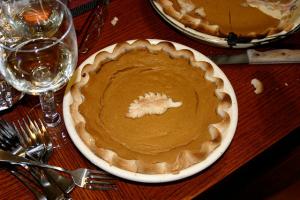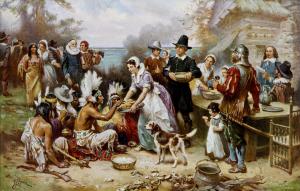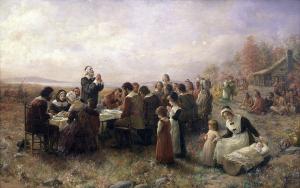In Book X of his Confessions, Saint Augustine struggles with excessive appetites and prays to consider food like medicine—to sustain the body but not amuse it. Many Americans actually do this, though not exactly Augustine’s sense. The American tendency to mince nutriment into its constituent parts might encourage eating for health, the sustaining of the body, but also imposes a rigid morality that makes feasting an occasion of guilt. As Dr. Aaron E. Carroll argues in the New York Times, “How I Lost Weight and Learned to Love Thanksgiving Again”, our tendency to moralize food, to label its elements noxious or vivifying rather than as goods to be taken in moderation, does not advance our flourishing.
Thanksgiving, as Carroll hints, is a holiday some of us do not love. There is a way to take Thanksgiving as an edifying civil holiday, one of the things we share as Americans, generating a vague warm contentedness expressed through the offer of overmuch bland food. There is a way to take Thanksgiving as a holiday of historical observance, though Robert Tracy McKenzie’s outstanding book shows how Americans can get this wrong. There is a way to take Thanksgiving as an ecclesiastical holiday, as churches in New England intended in their original, occasional days set apart for such public observation. Special feasts, though perhaps less important than special fasts, helped a community mark gratitude to God. Some Americans still make churchgoing a part of their Thanksgiving days.
Today is Monday before Thanksgiving, which means by today you should have your turkey defrosting if it is frozen. Tomorrow you shop and chop. Wednesday you brine. That day you may also bake things that do not properly share the oven with an onion-laced fowl: pies, rolls, cornbread. Thursday you roast, set, carve, eat, repackage, clean, sweep.
This meal-prep regimen is a liturgy of sorts. There is enough fixity to the Thanksgiving menu to require a certain order in order to make it turn out right. Without hired help, most would not be able to do it unless done with these stages. Home magazines frequently devise charts to help hosts survive the challenge. But even cursory readings of these Thanksgiving-planning charts hint at the jarring mismatch between the celebration expected and the struggles involved in attaining it. Even a title of such plans, “How to Get It All Done,” carries spiritual anxiety. Did we in our own strength confide, our striving would be losing.
The solution to this problem is rendering Thanksgiving both more and less spiritual. We can observe on the day an actual liturgy of Thanksgiving, for which some churchly resources may avail. The Episcopal Book of Common Prayer, for example, offers this collect for the day:
“Almighty and gracious Father, we give you thanks for the fruits of the earth in their season and for the labors of those who harvest them. Make us, we beseech thee, faithful stewards of thy great bounty, for the provision of our necessities and the relief of all who are in need, to the glory of thy Name; through Jesus Christ our Lord, who liveth and reigneth with thee and the Holy Spirit, one God, now and for ever. Amen.”
But we also can relieve food of some of its spiritual responsibilities by treating it, as Carroll recommends, not always as a guilt-inducing threat to be taken medicinally. Eating, at least on this occasion, really can be seasoned with thanksgiving. Harriet Beecher Stowe was not famous only for her execration of slavery in Uncle Tom’s Cabin, but for her positive if sometimes ironic appraisals of the habits of her New England forbears. In her novel Oldtown Folks, Stowe offers this etiology of the pie:
“The pie is an English institution, which, planted on American soil, forthwith ran rampant and burst forth into an untold variety of genera and species. Not merely the old mince pie, but a thousand strictly American seedlings from that main stock, evinced the power of American housewives to adapt old institutions to new uses. Pumpkin pies, cranberry pies, huckleberry pies, cherry pies, green-currant pies, peach, pear, and plum pies, custard pies, apple pies, Marlborough-pudding pies, –pies with top crusts, and pies without,–pies adorned with all sorts of fanciful fluting and architectural strips laid across and around, and otherwise varied, attested the boundless fertility of the feminine mind, when once let loose in a given direction.”
Stowe’s paean is not merely a theory of U.S. history or of gendered aesthetics, but a pretty full-throated endorsement of the good of creation, and obligation heartily to appreciate it as such. We could apply her praise to this most Thanksgiving-appropriate of desserts to the meal as a whole. As Stowe could advise Carroll, and the rest of us, immoderate thanksgiving makes moderate eating easier.













